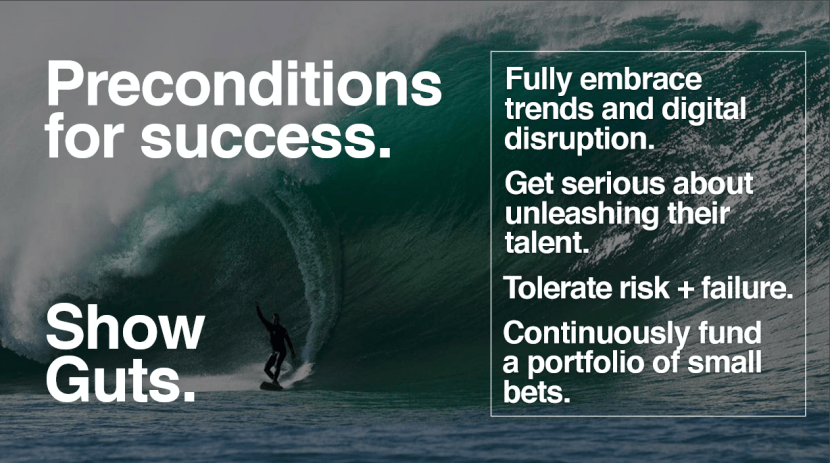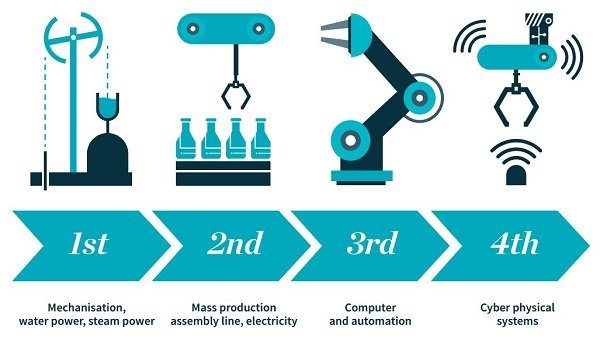 On our trip to Silicon Valley earlier this year, we had the luxury of discussing the intricacies of corporate innovation with globally-recognized innovation expert and co-founder and CEO of Mach49 Linda Yates.
On our trip to Silicon Valley earlier this year, we had the luxury of discussing the intricacies of corporate innovation with globally-recognized innovation expert and co-founder and CEO of Mach49 Linda Yates.
Mach49 is one of few companies that has perfected the formula to helping large corporations innovate successfully from within — or as they say, “disrupt from inside out.”
“There’s no reason large companies cannot innovate to create meaningful growth,” Yates remarked in an interview with us recently.
“You have the capital, the resources, the channels, the customers, and great talent. Are you really afraid of startups?”
And yet, even armed with all these resources at their disposal, large businesses are afraid.
Large Companies Fear Disruption

4 out of 5 executives fear being left behind as technology evolves faster than they can adapt.
In a Dell report from 2016, more than half of Asian company leaders believe their businesses will become obsolete in the next 5 years due to competition from startups.
The key finding from the Big Data Executive Survey 2017 showed that nearly half of the executives surveyed are worried about major disruption on the horizon.
Many believe that large businesses don’t have the agility or vision, and are too stuck in their ways to out-innovate startups.
Some give it a go, and dip their toes in what we call “innovation theater” — a massive call for ideas, a pilgrimage to Silicon Valley, an open floor plan. When none of these initiatives result in anything definitive, they throw in the towel and declare that they’ve given innovation a go but it doesn’t work.
Innovation is Not Rocket Science

Having had one foot in Silicon Valley, and one foot in the Global 500 almost her entire career, Linda Yates is one of those who are truly bilingual between the startup world and the corporate behemoths.
“People are now flocking to Silicon Valley, looking for that kind of innovation fairy dust to be sprinkled upon them, and we know that doesn’t work.”
“What we do know from our strategy, and from our work with large companies, is that they can absolutely innovate.”
Yates’ argument is that large companies have all the ingredients that startups don’t — which should give them the upper hand in innovation.
“It’s not fairy dust, it’s also not rocket science. If you think about what Silicon Valley is really good at, it’s fairly straightforward — we understand customer pains.”
Point #1: Understand Your Customer
Surveys are not the way to go.
“Surveys are statistically significant and strategically irrelevant,” chuckled Yates.
“All you’ve done is outsource your potential to understand your customer at a visceral level and develop empathy for your customer, to someone who’s just going to repackage what they learn and sell it to somebody you know.”
When presenting keynotes to global company boardrooms, a question Yates often asked was how many customers they have actually interviewed.
“90% of hands do not go up. 90% of board members have not actually spent time understanding their customers’ pains.”
“Nobody would say they wanted a DVR, a microwave oven, or a Mini. What they would usually express is the pain from not being able to get home to watch their favorite TV shows on time because they were stuck at work, not having the time to make a 4-course meal but still wanting to eat healthy, not having a vehicle that makes it easy to cart an ever increasing number of pets, equipment, kids to myriad places.”
“Our job is to understand customer pain, not ask customers what they want.”
Understanding customer pains is one of the core set of best practices when it comes to innovation.
“We teach companies how to actually interview customers, and understand customer desirability.”
If desirability is huge, then you identify the opportunity and move on to product, service or execution feasibility.
Where companies go wrong:
The mistake many companies make is investing too much time, energy and money into developing a product. At that point, they’re so invested in that product that they’re no longer interested in the customer pain.
“All they’re interested in is showing you the product and asking, ‘what do you like about it?’, when really, people are saying they didn’t want it, don’t need it, but are just too polite to tell you.” said Yates.

Point #2: Marry Customer Pain with the Art of the Possible
Startups are very good at understanding customer pain and marrying that knowledge with the art of the possible (both trends and technology) to come up with a solution. They then place a series of small bets to test their solution.
Understanding the art of the possible is why so many companies decide to visit or set up an office in the Silicon Valley, but innovation happens globally and you do not have to be in Silicon Valley to be successful — you just have to stay on top of the latest trends and technology.
While Yates is not a huge fan of “corporate tourism”, Mach49 does help curate visits for companies that need a Silicon Valley immersion experience to create the sense of urgency that now is the time to disrupt themselves before being disrupted.
Yates says, “We do these very differently, helping companies define a challenge, curating visits relevant to that challenge and wrapping up the week with a “Blitz” — our design thinking workshop on steroids — to ensure they go home with real action items based on what they learned during the week.”
Point #3: Place Small Bets
Many senior executives feel that fueling growth from innovation would be too expensive, risky and difficult. They’re afraid that devoting time and energy to untested waters could derail their core business that’s the cash cow today.
While no one can deny that new ventures are risky business, staying stagnant and not growing in times of constant change is a surefire way to cement a company’s irrelevance and future demise.
There is however, a systematic way to remove the bulk of the risk associated with innovation — a process that most innovation experts call “placing small bets.” This helps remove the greatest amount of risk on the least amount of capital.
“It’s important to place a series of small bets and then unlock additional rounds of funding as you remove the layer of risk — the risk can be market risk, financial risk, it can be a technical risk. All those things have to be thought through.”
Where companies go wrong:
Placing too big a bet.
“Big companies, when they do innovation, they try to boil the ocean. They want to shift the whole oil tanker. But you know, large scale intervention just doesn’t work.” said Yates.
Doing too much at one go, spending too much money without validating the process and risks involved is usually what gives innovation an expensive price tag with no significant returns. Companies that do this end up ticking the “innovation” box, decide it doesn’t work, move on and head towards their own Kodak moment.
Point #4: Make the Shifts You Need for Transformation

Many new ventures face almost certain death when shoved into the existing systems, processes and culture in a corporation. The legacy structure has been fine-tuned over years, even decades, to ensure the success of the established business, with financial and operation models that get in the way of the emerging business.
“There are very significant from-to-shifts that large scale companies have to make to ensure that these new ventures reach escape velocity, that they don’t suffer from the inertia, the antibodies, and the orthodoxies and get killed by the organization,” explained Yates.
Mature corporations have to think about what’s going to get in the way of their innovation initiatives actually becoming successful.
“Is it the metrics we use to measure it? Is it the way we compensate people? Is it the way we resource? Is it our procurement process that takes 6 months to get a new vendor through?” she questions.
Xerox built the world’s first personal computer but failed to capitalize on it, partly because they tried to sell it through their existing sales channel, which in the end resulted in failure because the customers that bought the copy machines simply weren’t the same customers that would purchase the new products.
Ask yourself, “What are the from-to shifts that your departments would have to make to help the new company reach escape velocity?”
Where companies go wrong:
Many corporate leaders complain that their business units have great ideas but just won’t make any investment — but they forget to take into account the limits of their existing structure.
“I ask them ‘how do you pay them? what are their metrics for compensation?’ Like zero for innovation, 100% for making the bottom line and rolling that up.”
Yates remarked that by nature, innovation doesn’t have any net profit attached to it, so it’s unrealistic to ask people to commit themselves to it unless there is an incentive to make that happen.
You need different goals and operational metrics for the teams running the new business ventures.
At Mach49, they help companies create, build, and launch new ventures by applying a very robust set of methodologies during a 12-week incubate process that includes customer desirability, determining product / service execution feasibility, and ensuring business viability.
“We also work with the mothership to help them think about the from-to shifts they will have to make to ensure the new venture can be a success. The goal is ultimately to help the company build the capability to create a pipeline and portfolio of new business opportunities on their own, ideally building their own internal incubator with their own team.” Yates explained.
“During the customer desirability phase, we work with the company’s new venture team to do 100 to 200 customer interviews. We conduct a very robust market assessment to ensure that there is strong customer interest. One client had 10,000 people sign up for a product that didn’t even exist yet, at that point we knew there was a market,” noted Yates.
Point #5: Unleash Your Internal Talent

Sometimes we get caught in the legacy trap. Afraid that something new might alienate our existing customers and threaten our net income levels, and possibly even render our jobs irrelevant. But Yates believes that fear is unwarranted.
“The people running the core business don’t want this innovation to happen because they feel that it threatens their existence and eliminates their reason for being. In fact, the opposite is true.”
She pointed out that there are three types of people in any organization — each serving very different functions, yet complementing one another.
The Internal Entrepreneurs
Internal Entrepreneurs aren’t the people running the core business, but instead are the idea-a-minute person who are close to the customers, have great ideas and just want to be given the opportunity to test them. These people are like startups, or in Silicon Valley terms, early stage founders. Many of these people are not experienced enough, and possibly don’t have the attention span or interest, to run their companies long-term. They stay in the incubator and launch the next thing while handing over the venture they’ve been working on to the next type of people typical in a company.
The Growth Experts
These are the ones who are really good at growing businesses. They’re not really the idea people, but they’re the ones who can take an idea and understand how to grow it 15-20% a year. They know how to recruit people, how to manage people, and how to run the business.
“Some of the best startups in Silicon Valley resulted when brilliant, but perhaps less experienced entrepreneurs knew they needed help growing the business and brought in a more seasoned veteran to both lead and teach them.”
An internal entrepreneur is lucky, they are already surrounded by experienced veterans who can take their venture and grow it.
The Efficiency Experts
The third type of people are the ones who knows how to manage a business like no other. They can operate efficiently, they know how to reduce costs without reducing quality. These are the type of people typically running the core and legacy businesses.
“If they’re smart, they look at the entrepreneurs as the people who are going to basically fuel their pipelines for years to come, because as big as the business is, it’ll fade a la Kodak, a la Motorola, a la the printing business.”
Where companies go wrong:
Believing that they do not have the capacity to innovate. Having worked with corporate innovation since 1994, Yates strongly believes that all companies have the resources, internal talent, ideas, capital, and customers needed to pursue innovation without having to waste millions or billions on a potential failure.
Point #6: Leverage Your Resources

A big argument for several companies is that they do not have the budget or resources for innovation.
Yates begs to differ.
“If you’re paying dividends or cutting costs, that just tells me that you have the money to invest in innovation. And the beauty of it is that it does not have to be expensive.”
It can start small, it doesn’t have to be a massive overhaul, but it helps sow the seeds for the future. The key (as mentioned above in point #2) is to methodically test and remove risks before channeling more money and resources into the project.
If we look at startups, they’re typically funded with a minimal amount of money to kick off — $50,000, $150,000, $500,000 etc. And then they go through a process, proving their hypotheses and market feasibility to unlock more funding to build upon the business.
“As long as you have a rigorous and robust methodology for doing that, then you’re on the right track,”
Where companies go wrong:
Doing “innovation” without any conducive measures or systems in place. Examples include setting up an innovation unit that still has to adhere to organizational constraints, appointing a Head of Innovation who doesn’t have power, and not defining any metrics on corporate venturing.
Point #7: Run both the Core and New Business Concurrently

The whole point about investing in innovation isn’t to push your existing business model aside, but to build on it and expand it for the future.
“You know your product is going to have a lifetime and it’s ultimately going to fade. But it doesn’t matter as long as you are continually reinventing yourself,” said Yates.
In the context of the Norwegian economy, which relies a fair bit on the oil & gas industry — it’s understandable to want to keep optimizing the efficiency of its core business. But while doing so, it also makes sense to leverage the vast amount of data and knowledge they have built up over the years from running the business, and see what they could be doing with that from a business standpoint.
“What could you be doing in terms of alternatives? What could you be doing in terms of digital disruption? What could you be doing about enabling small, medium-sized businesses around energy or consumers around energy?” asked Yates.
She aptly analogized the oil industry as an oil tanker.
“You send out a series of speedboats and tugboats that are tethered to the oil tanker. Ultimately, you’d have sent out enough of those that you can shift, if not, you can continue to run your core business, but they have to simultaneously be thinking about what’s next.”
Where companies go wrong:
Being overly protective of the core business and not keeping up with the pace of change, instead of adopting a methodology that works to help you develop a portfolio of new ventures.
__________________________

Linda Yates is the co-founder / CEO of Mach49. Working under the motto “Disrupting Inside Out”, Mach49 helps large organizations create, build, and launch new ventures generated from within. Based in the middle of the Silicon Valley, Mach49 works with a host of global companies, including a handful from the Nordics.
Engage // Innovate collaborates with Mach49, and will bring its first Norwegian client to Mach49 later this year.

Do you want to learn more?

























 On our trip to Silicon Valley earlier this year, we had the luxury of discussing the intricacies of corporate innovation with globally-recognized innovation expert and co-founder and CEO of Mach49 Linda Yates.
On our trip to Silicon Valley earlier this year, we had the luxury of discussing the intricacies of corporate innovation with globally-recognized innovation expert and co-founder and CEO of Mach49 Linda Yates.






